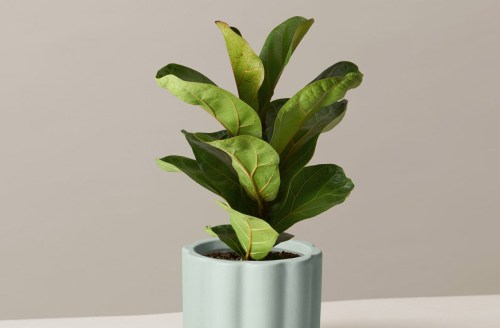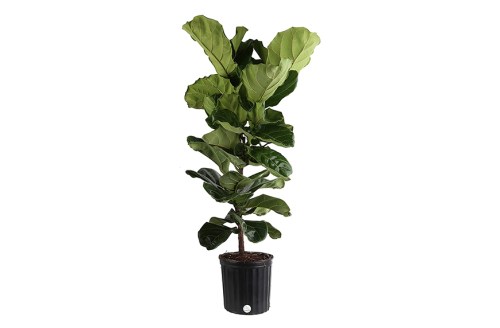Our editors independently select these products. Making a purchase through our links may earn Well+Good a commission
How To Care for Your Fiddle-Leaf Fig, the Most Dramatic of All Houseplants
I don't want to throw shade (especially because it hates the shade), but learning how to care for a fiddle-leaf fig is easier said than done.

Now, I don’t want to shade fiddle-leaf figs in any way (especially because they hate the shade), but this plant is by far the most dramatic houseplant. It’s basically the equivalent of a significant other who, unless the thermostat is kept to just the right temperature, throws a fit. Alas, in the end, we deal with its high-maintenance nature because… well, just look at it—it’s beautiful. But learning how to care for a fiddle-leaf fig is easier said than done.
Experts in This Article
plant expert and founder of Greene Piece
While many people prize the fiddle-leaf fig as a showstopping houseplant, Ficus lyrata is a plant species native to West Africa, where it grows in lowland tropical rainforests. Many tropical plants have adapted to life indoors, but the fiddle-leaf fig is more temperamental than the rest. I mean, I know people who water them with better water than what they drink themselves. The good news is once you see it thriving, the struggle is more than worth it.
In the latest episode of Greene Thumb by Well+Good, the plant doctor Maryah Greene explains exactly how to care for your fiddle-leaf fig. “I always say there’s a reason I know how to care for just about every plant. It’s because at one point or another, I’ve killed just about every plant, and believe it or not, the fiddle-leaf fig was the first one,” says Greene.
How much light your fiddle-leaf fig needs
Unlike other plants that can tolerate both low light and bright light environments (looking at you, monsteras!), the fiddle-leaf fig will have none of that. It needs to be put in a spot that has a lot of bright, indirect light. It also needs a few hours of direct sunlight every day.
“The first and most important thing that you should consider before bringing home a fiddle is lighting. When I brought my fiddle home, I brought it into a room with a north-facing window, and little did I know, I was kind of setting myself up for failure,” says Greene. “Fiddle-leaf figs enjoy lots of light and they can often take up to five hours of direct light a day.” According to Greenery Unlimited, it does best “close to south- or west-facing windows, or directly in an east-facing window,” and nothing can be anything blocking that light (like a building or trees). You also need to rotate it once a month since it grows toward the sun.
Aside from these lighting requirements, you also can’t give it too much sunlight right away—it has to be eased into it. Otherwise, the fiddle-leaf fig’s pretty green leaves may burn and develop brown marks. Too little sunlight, on the other hand, will cause its leaves to turn yellow or brown, or worse, fall off. You can’t move it around too much, either, because it hates that and may drop its leaves. Probably out of spite. It might take some trial and error, but you’ll eventually find the right placement for your plant—even if it gets some battle wounds in the process.
“If you have a fiddle-leaf fig already and you feel like it’s not getting enough light, one of the things you can do to supplement that light is adding a grow light ($23),” says Greene. “They’re awesome, especially if they come with the timer, because you can automatically set how much light it’s receiving every single day.”
How to water your fiddle-leaf fig correctly
No surprise, but watering your fiddle-leaf fig is an exceedingly important part of its care. If you overwater your plant, you’re in trouble—it’s super susceptible to root rot. Under-watering it, on the other hand, can cause it to become dry and result in damaged leaves. Because it likes its soil to be moderately moist, your best bet is thoroughly watering it when the top two inches of soil is dry. You can stick your finger into the soil to check.
“You want to make sure that your fiddle-leaf is always on a consistent watering schedule and that its pot has a drainage system. The watering schedule for your fiddle-leaf fig is really dependent on how large it is and how much light it’s getting,” says Greene. “If your fiddle is getting a ton of light, you can almost assume that the water is evaporating and being absorbed at a much quicker rate, so you may only need to water it between every one to two weeks; it just depends on the size.”
The right temperature for your fiddle-leaf fig
The fiddle-leaf fig doesn’t like any changes in its placement, and it also doesn’t like changes in the room temperature. Because of that, make sure you’re keeping your indoor temperature consistent year-round. Generally, that should be between 60°F and 75°F. It also can’t tolerate any cold air drafts, so make sure it’s in a place that stays stable.
Since it’s a tropical plant, it also likes a little humidity. And if your leaves have brown edges, it’s a sign that it needs more of it. To up the humidity, you can lightly mist it regularly, or set your humidifier(s) up next to it so it feels like it’s in a rainforest. “You might need a few humidifiers to bring the humidity up. You want it up over 50. Really, 60 to 80 percent is what they’re after. If not, they’re going to drop leaves,” Amanda Switzer, the plant expert behind Planterina, said in a YouTube video.
How to clean your fiddle-leaf fig
When you have a fiddle-leaf fig, you’ve gotta add it to your weekly cleaning list. Like all houseplants, they collect dust—but since their leaves are big, they tend to have even more pile up. To keep them healthy—and allow them to absorb all the sunlight they need!—lightly wipe the dust from their leaves with a soft cloth as needed.
“Wiping down the leaves is one of the best things you can do for your fiddle-leaf fig,” says Greene. “Over time, if dust starts to develop over the top, then it can prevent your fig from getting as much light as it often should. So if you wipe your leaves once a month to every six weeks, it’ll be much happier.”
And once you’re done misting your fiddle’s leaves, spray them with a plant mister ($12). “Misting restores moisture back into your plant’s leaves, and it’s something you can do as often as you want as long as you’re focusing on the top and bottom of the foliage,” says Greene.
When to repot your fiddle-leaf fig
To ensure your fiddle-leaf fig thrives, it need an appropriately sized home. Greene says that a new fiddle-leaf fig should be removed from the grow pot with care and placed into a pot that’s one to two inches bigger, giving it room to grow. Then, it’ll need repotting every one to two years depending on its size.
“Common signs that it’s time to repot your fiddle-leaf fig include seeing equal rates of growth and death. You might see new leaves popping up at the top and then you might see some older leaves dropping off at the bottom. It means that the roots of your plant have completely run out of space inside of the pot, so it’s time for more room,” says Greene. “When you’re repotting, you want to make sure you’re using fresh soil, and make sure that the soil has tons of drainage in it, such as [added] pearlite ($16) or some sort of volcanic rock ($15) that keeps your fiddle-leaf fig dry in between waterings.”
Where to buy a fiddle-leaf fig
Ready to care for a fiddle-leaf fig of your very own? (You can do it!) While you can find a plant in greenhouses or local plant shops, it’s also available for purchase online in many different sizes.
1. The Sill, $67
This little guy might be small now, but with proper care, it can grow up to six feet or taller. This one comes with a cute pot, too.
2. Amazon, $80
Did you know you can buy live plants on Amazon? This one will arrive straight to your door within one to two weeks. It’s also already 4.5 feet tall, giving you a great size to start with.
3. Home Depot, $25
This is a true score. The plant comes in a 9-inch grower container, allowing you to place it in your favorite ceramic pot in seconds.
Oh hi! You look like someone who loves free workouts, discounts for cult-fave wellness brands, and exclusive Well+Good content. Sign up for Well+, our online community of wellness insiders, and unlock your rewards instantly.
Sign Up for Our Daily Newsletter
Get all the latest in wellness, trends, food, fitness, beauty, and more delivered right to your inbox.
Got it, you've been added to our email list.











